THE MAN WHO WOVE THE WEB
John Naughton profiles the modest Briton who transformed the world
FOR a man who has invented the future, Tim Berners-Lee does not look like a charismatic figure. He is a youthful fortysomething who dresses neatly but casually, drives a Volkswagen and has none of the vices traditionally associated with great men. Yet an aura clings to him, gen- erated not just by what he has achieved, but even more so by what he has chosen not to do. For this is a man who has creat- ed something that will one day be bigger than all the other industries on earth.
His intellectual property rights could have made him richer than Croesus, yet he turned his back on all that to work for the common good. Berners-Lee now works from a spar- tan office at MIT's computer-science lab, where he draws a modest salary as head of the World Wide Web Consortium (W3C), the body which tries to maintain technical order in the burgeoning technology of the Web. Until recently, he wasn't even a pro- fessor, though MIT has now put that right and given him an endowed Chair. No won- der that whenever he appears in public the images that come to mind are not those from Kubrick's film 2001, but from 'The Road Not Taken', Robert Frost's poem about the choices we make in life:
Two roads diverged in a wood, and I
— I took the one less travelled by, And that has made all the difference.
Berners-Lee has software in his blood. Both his parents were programmers who worked for. the British company Ferranti on one of the first commercial computers. He read physics at Queen's College, Oxford, where he built his first computer with a soldering iron, a microprocessor chip and an old television set. Graduating in 1976, he worked for Plessey and later for To order A Brief History of the Future or Ingenious Pursuits, post free in the UK please call The Spectator books/sop on 0541 557288. a firm writing typesetting software.
In many respects, he looks like an Englishman from central casting — quiet, courteous, reserved. Ask him about his family life (he has an American wife and two children) and you hits polite but blank wall. Ask him about the Web, however, and he is suddenly transformed into an Italian: words tumble out and he gesticulates wild- ly. There's a deep, deep passion here. And why not? It is, after all, his baby.
The strange thing is that it all happened because he has a terrible memory. Names and faces often elude him. 'I needed some- thing to organise myself,' he says. 'I needed to be able to keep track of things, and noth- ing out there — none of the computer pro- grams that you could get, the spreadsheets and the databases — would really let you make this random association between abso- lutely anything and absolutely anything.'
So in the end he wrote such a program himself while on a six-month consultancy at Cern — the European centre for research in particle physics — in 1980. He called the program Enquire (for 'enquire within about everything') and describes it as a 'memory substitute', which enabled him to fill a document with words that, when high- lighted, would lead to other documents for elaboration.
When his attachment ended, Berners-Lee returned to Britain and helped found a start- up company doing computer graphics. But the lure of Cern endured and he returned there in the late 1980s charged with support- ing the lab's retrieval and handling of infor- mation. What struck him was how, at an institutional level, the laboratory suffered from the same memory problems as himself.
'Cern is a vast organisation, doing research of unimaginable complexity. Most of its experiments are conducted by teams of visiting physicists. Maintaining coherent documentation in such circumstances, with so many people coming and going, was a nightmarish task.
Berners-Lee felt that the research insti- tute needed some way of consolidating its organisational knowledge. So at the begin- ning of 1989 he sat down at a Macintosh computer and hammered out a proposal that would change the world.
What was needed was some kind of linked information system — a prosthesis for a chaotic organisational memory. He proposed something based on 'hypertext' or 'non-sequential writing' — a method of composition in which parts of a document can be linked to parts of an entirely differ- ent document, rather like footnotes in a conventional book. He suggested building an experimental hypertext 'web' for the international community of physicists who used Cern and its publications.
It took the Cern management some time to give the go-ahead, but when they did, in November 1990, Bemers-Lee created the software needed to make the Web a reality with astonishing speed. In December 1991 the laboratory's computer newsletter announced the creation of the 'World Wide Web'. It had taken just over a year from the moment Bemers-Lee typed the first line of code.
As a concept, hypertext was old-hat, dat- ing back to the 1940s. Berners-Lee's great ideas were to make it global and usable by ordinary people. It is important to remem- ber that even in 1989 the Internet was a vast information resource with thousands of archives and millions of documents. However, accessing the Net was akin to using the MS-DOS or Unix operating sys- tems — you could do almost anything pro- vided you knew the lingo. The trouble was that the lingo was user-hostile. Computer freaks took to it like ducks to water; the rest of humanity looked the other way.
Berners-Lee overcame this by inventing an interface — a program called a 'brows- er', which stood between the user and the vast and disparate information resources of the Net. It was, in effect, a window that dis- played cyberspace in an intuitive way. To this notion of a browser, he added several other key ingredients: a 'server' program which would enable computers to dish out Web pages on demand, a standard method of formating these pages, and a protocol governing the exchange of documents across the Internet.
It is not so much the elegance of Bern- era-Lee's creation which makes one gasp as its blinding comprehensiveness. In little over a year he took the Web all the way from its conception, through the hacking out of primitive browsers and servers, to the creation and elaboration of the proto- cols needed to make the whole thing work. And on the seventh day he rested.
The author is the Observer's Internet colum- nist. A Brief History of the Future, his book on the origins and significance of the Internet, is published by Weidenfeld and Nicolson.



















































































 Previous page
Previous page